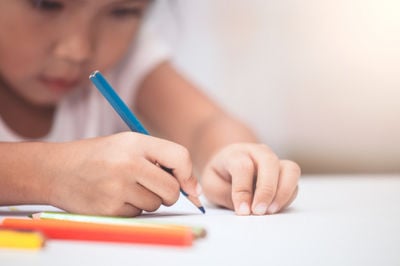3 Easy Steps to Apply Correction Techniques

In a classroom, teachers assist students to transfer new knowledge to receptive knowledge, then further to product knowledge. Take English as an example, learning involves pronunciation, meaning, usage, grammar, etc., mistakes are frequently spotted while checking all the boxes. It is rather vital for teachers to deploy correction techniques to right the wrong use, to motivate students to learn from mistakes and to build the correct mindset towards mistakes. Hence, it has been widely accepted that to correct mistakes is one of the basic responsibilities of a teacher. Necessary and proper corrections are justified as an effective way for students to absorb and use the new language. Any underestimation and underuse of correction techniques might exert negative impacts.
Table of Contents
1. Correction should be language problem-oriented
2. Correction should be learning-motivated
3. Correction should be psychology-concerned
Are you ready to teach Englis abroad?
Once we realized the significance and urgency of applying correction techniques, then, how exactly to exercise in class is another concern. In order to answer this question, there are some certain guidelines to grasp.
This post was written by our TEFL certification graduate Zhengwei Y. Please note that this blog post might not necessarily represent the beliefs or opinions of ITTT.
1. Correction should be language problem-oriented
First, a language problem-centered application means teachers should focus on the language, like pronunciation, grammar, and usage, etc., whether the speech itself is fact-based or totally biased, is not relevant. Corrections from the teacher should only pose a profession on the language, not on a particular topic or certain field. Irrelevant discussions and unnecessary corrections might hinder the teaching and learning process.

Secondly, considering the large scope of language learning difficulty, there is no "a cure for all" kind method in a correction. Teachers often spot mistakes in language sponging (receptive) and language using (productive) stages. Based on the learning difficulty, there are many factors and various approaches to look at. Efficiently applying correction techniques for different problems can reduce time on the struggle, and help students to retain a better understanding about the mistake. For example, drilling could be used for pronunciation correction, however, if the student keeps pronouncing wrongly, and fails to identify the differences between the right and wrong, drilling can be very unproductive and frustrating. At this point, teachers should refer other approaches, like articulation, close-up presentation, and teaching aids (videos and voice recorders) etc..The extent of possible mistakes should drive teachers to have rather profound knowledge on correction techniques so that they can better tackle problems in class.
Also Read: How Grammar Influences a Language Acquisition
2. Correction should be learning-motivated
Simply spot the problem and then move on to correct it has been recognized problematic, it has been believed that through correcting mistakes student could learn more than just the right answer. Straight forward correction usually fails to produce deep thinking, and teachers should avoid any spoon-feeding gesture as well. The process of correcting students could be informative. Teachers should guide through the thinking process, and stimulate learning, maximizing student's participation and minimizing their own intervene. In this way, it is possible to turn correction as a "sweet spot" not a "breaking point".
A good class should combine self-correction, peer correction, and teacher elicitation together with necessary aids. The teacher helps students to identify problems, and then lead them to correct themselves, if possible. In this way, students are more likely to avoid the mistake in the future. Plus, if students fail to make self-correction, simply make this attempt would emphasize the language point. From this angle, the correction process also helps teachers to assess students' language free using the ability, therefore, a learning-promoted application of correction techniques is rather desirable in the classroom.

Also Read: Benefits You Can Get if You Obtain a TEFL Certificate
3. Correction should be psychology-concerned
The teacher is a crucial influence on the way students perceiving and dealing with mistakes. Proper correction can help students establish a rather positive mindset towards learning. This section projects light on learners' psychological perspective, we briefly examine factors like, the timing (when), possible correct roles (who) and teachers' behaviors, to understand how to effectively apply correction approaches, also create a right image of mistake correction.
Teachers should recognize the timing justly. So when to act? Preferably, corrections should mainly happen in study and feedback phrases. During engage and activate sections, fluency is prioritized, and if teachers have to correct, they can pose a light touch, such as to rephrase the wrong sentence and also avoid over correction. Correcting too much or too frequently might suppress students' willingness to express.

Then, as correction proceeds, surely teachers' tone and body language are involved. The way they speak would give away tons of information and implication. For instance, as it has been suggested in the course, teachers' language weighs tremendously in building rapport. Even responding to mistakes, positive language and a friendly tone are desired to smooth out any possible uncomfortable situation. This is very crucial to build a relaxed, engaging, and friendly climate.
Finally, apart from teacher and student, peer correction is another feasible approach and plays an important role in this game, especially for a new teacher with an existing class. However, peer learning can also be transferred to peer pressure. Therefore, applying correction techniques also requires teachers' critical thinking, based on their judgment and rich experience to make the right decision.
Are you ready to teach Englis abroad?
Learning a new language requires efforts on reading, speaking, listening, writing to decode and develop a full language skill set, which obviously is a hard plowing process, especially for students without constant language exposure. Learning environment without the right examples and mistake corrections can be very difficult for learners to master the accuracy and fluency. Teachers' role on correction is crucial, as we discussed in this essay, correction techniques cover tons of details, sometimes an approach that functions well in one case, might fail another. In order to better serve their role, a well-established understanding on correction techniques is no more than a good starting point for all the teachers, they need bring their correction skills to a well-mastered craft through constant exercise and testing.
Apply now & get certified to teach english abroad!
Speak with an ITTT advisor today to put together your personal plan for teaching English abroad.
Send us an email or call us toll-free at 1-800-490-0531 to speak with an ITTT advisor today.
Related Articles:
- Evaluation and Testing of Students in the ESL Classroom
- 10 Questions You Need to Ask Before Enrolling In a TEFL Course
- 11 Fun ESL Activities for Young Learners
- Online or In-Class - Which TEFL Course Should You Take?
- The Best Government Programs For Teaching English Abroad
- ESA Methodology - What Is It and Why Should You Use It In The Classroom?



